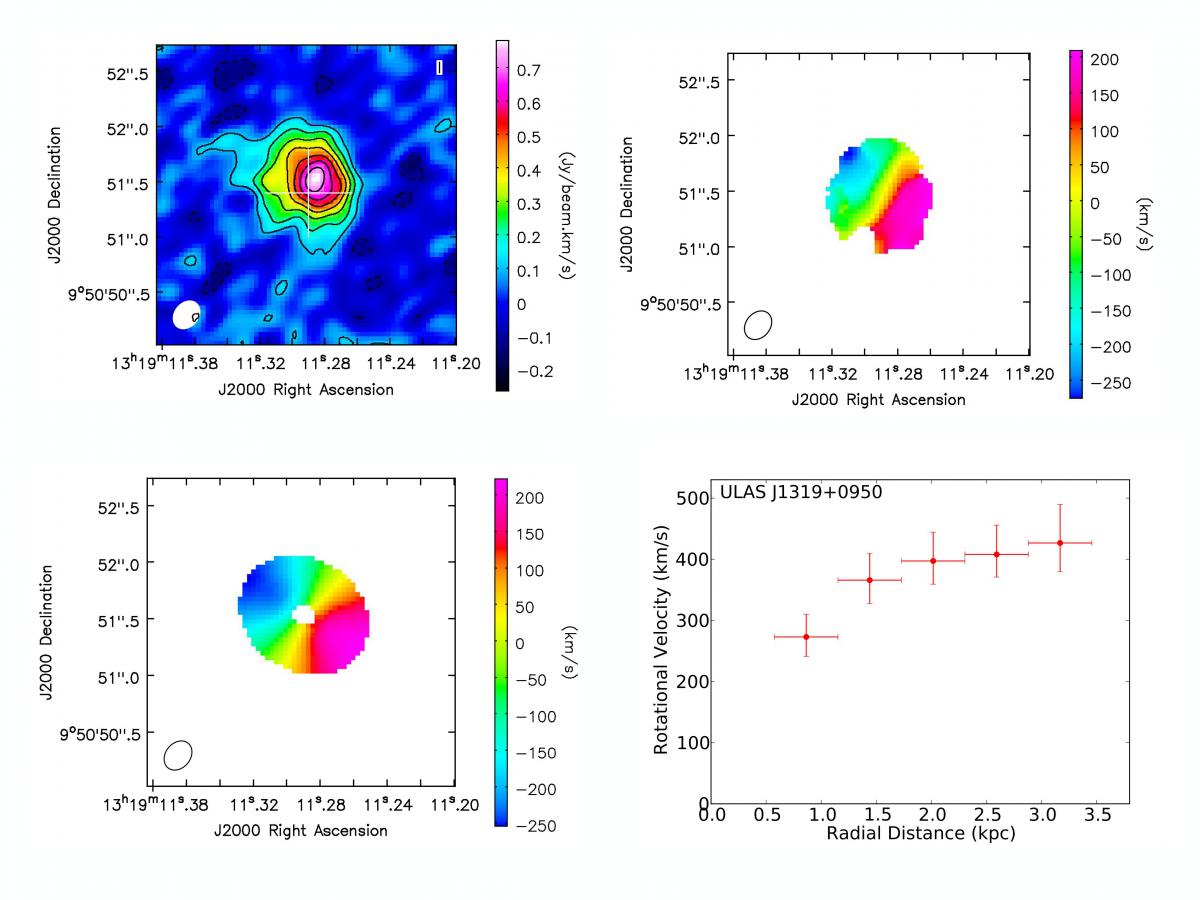The Atacama Large Millimeter/Submillimeter Array (ALMA). Photo credit: ESO/C. Malin.
In recent years, more than 200 quasars above redshift 5.7 have been discovered in large optical and near-infrared surveys. These quasar-starburst systems provide unique laboratories to study the formation of the first supermassive black holes and their host galaxies close to the end of cosmic reionization.
Bright [C II] 158 μm fine structure line emission has been widely detected in high redshift quasar-starburst systems. The [C II] line is one of the primary coolants of the star-forming interstellar medium (ISM). Thus, it directly traces the distribution of star formation activity and kinematic properties of the atomic/ionized gas in quasar host galaxies. Fourteen 5.7 < z < 7.1 quasars have been observed with ALMA sub-arcsec resolution, and the inferred source sizes are 1.5−3.3 kpc. Six of them show clear velocity gradients, providing constraints on the dynamical mass. In these objects, the black hole to bulge mass ratio appears to be above the correlation defined by local objects. However, these studies were limited by the moderate angular resolution of the early ALMA observations (typically 0.7”), resulting in a strong degeneracy between inclination angle and intrinsic rotational velocity.

TOP LEFT: The [C II] velocity integrated map which presents a source size of 3.57 X 2.94 kpc. TOP RIGHT: The observed velocity field. An clear velocity gradient is obvious. BOTTOM LEFT: The tilted ring model. BOTTOM RIGHT: The rotation curve.
Ran Wang’s group works on the ISM property of far-infrared (FIR) luminous quasars above redshift 5.7. They selected FIR luminous quasars using IRAM-30 m telescope and James Clerk Maxwell Telescope (JCMT), and found significant star formation activity with star formation rates (SFRs) from a few hundred to thousand solar mass per year in the quasar host galaxies. They also detected CO (2-1) line emission from a few redshift 6 quasar adopting Karl G. Jansky Very Large Array (VLA), which indicates abundant molecular gas with mass in an order of 10^10 solar mass. Their recent paper studying the gas dynamics of a luminous z = 6.13 quasar ULAS J1319+0950 revealed by ALMA high resolution observations (a graduate student Yali Shao as the leading author) was highlighted by the American Astronomical Society (aasnova.org) on 6 September 2017. They combined the ALMA new Cycle 1 data with Cycle 0 data. The combined data [C II] line emission have an angular resolution of 0.3” and resolve both the dust continuum and the [C II] line emission on few kpc scales. The combined data confirm the [C II] velocity gradient that was previously detected in lower resolution ALMA image from Cycle 0 data alone. They applied a tilted ring model to the [C II] velocity map to obtain a rotation curve, and constrain the circular velocity to be 427 ± 55 km/s at a radius of 3.2 kpc with an inclination angle of 34 degree. They measured the dynamical mass within the 3.2 kpc region to be ~ 13.4 ×10^10 solar mass . This yields a black hole and host galaxy mass ratio of ~ 0.020, which is roughly 4 times higher than the present-day MBH/Mbulge ratio. This suggests that the supermassive black hole grows the bulk of its mass before the formation of the most of stellar mass in this quasar host galaxy in the early universe.
Published paper: http://iopscience.iop.org/article/10.3847/1538-4357/aa826c
Link in AAS Nova: http://aasnova.org/2017/09/06/alma-finds-hints-of-early-black-hole-growth/
PKU News:http://pkunews.pku.edu.cn/xwzh/2017-10/16/content_299473.htm